Ethical and Legal Consideration in Nursing Discussion 2022
VerifiedAdded on 2022/10/11
|18
|1492
|28
Presentation
AI Summary
Contribute Materials
Your contribution can guide someone’s learning journey. Share your
documents today.
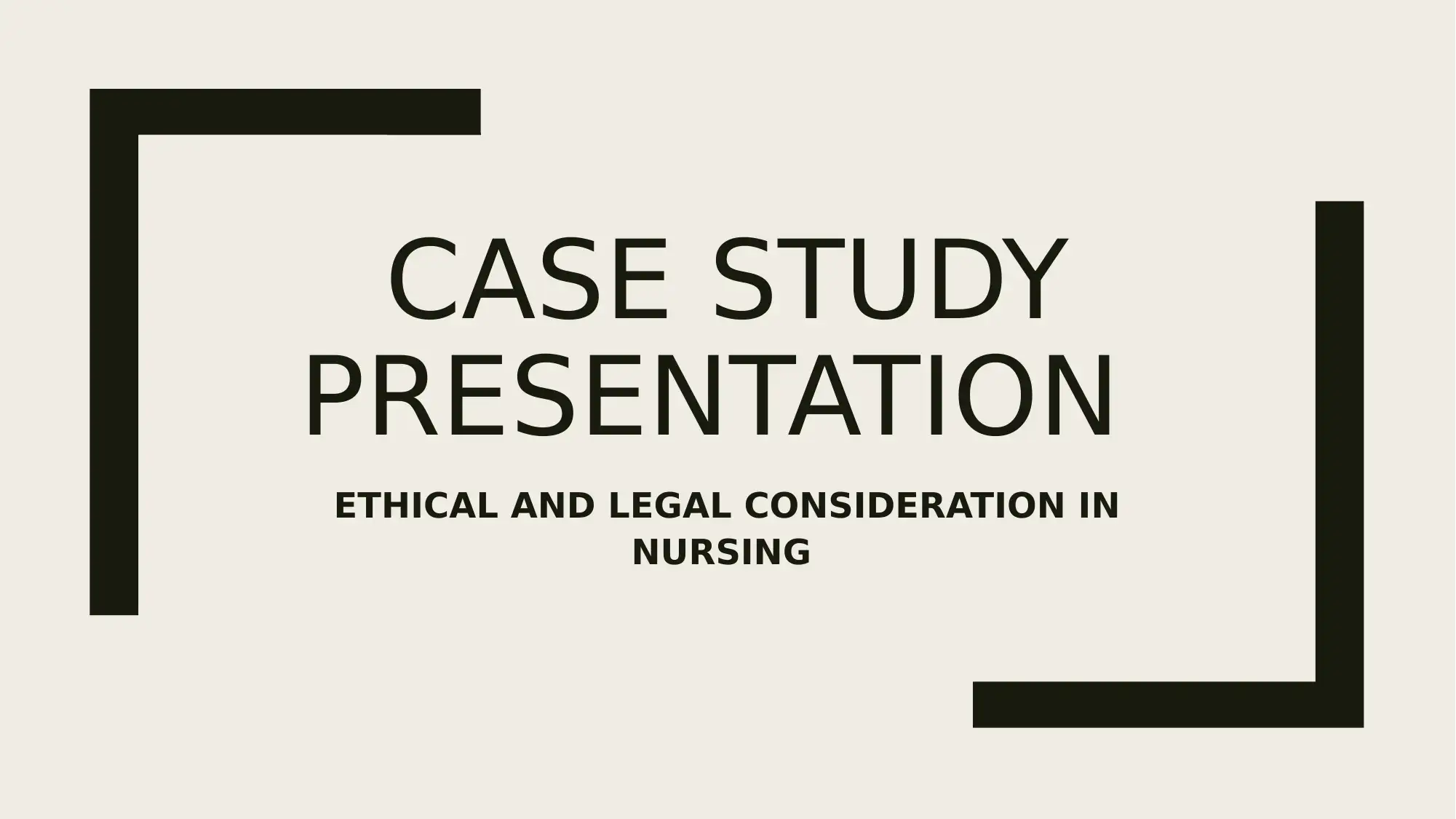
CASE STUDY
PRESENTATION
ETHICAL AND LEGAL CONSIDERATION IN
NURSING
PRESENTATION
ETHICAL AND LEGAL CONSIDERATION IN
NURSING
Secure Best Marks with AI Grader
Need help grading? Try our AI Grader for instant feedback on your assignments.
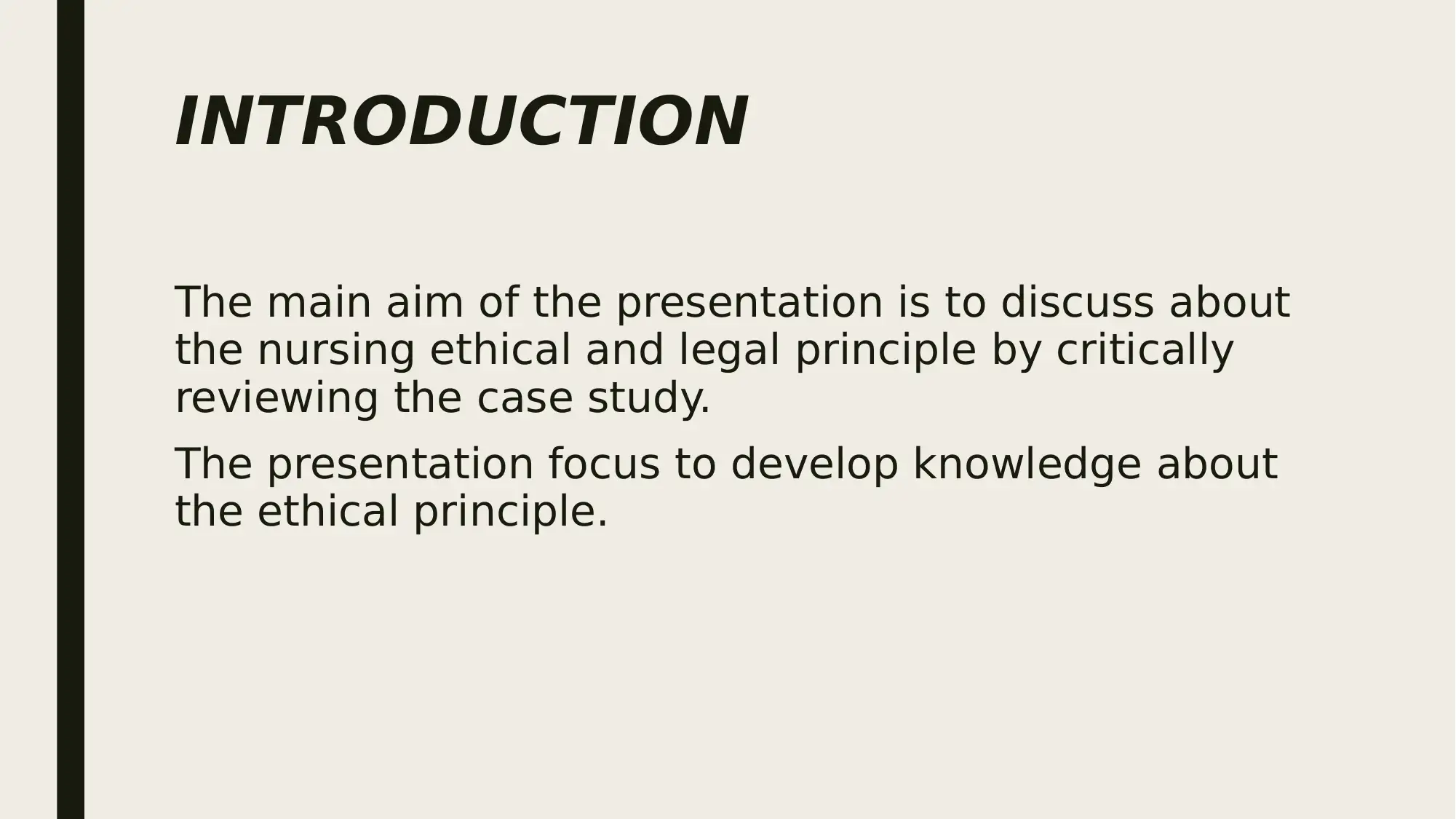
INTRODUCTION
The main aim of the presentation is to discuss about
the nursing ethical and legal principle by critically
reviewing the case study.
The presentation focus to develop knowledge about
the ethical principle.
The main aim of the presentation is to discuss about
the nursing ethical and legal principle by critically
reviewing the case study.
The presentation focus to develop knowledge about
the ethical principle.
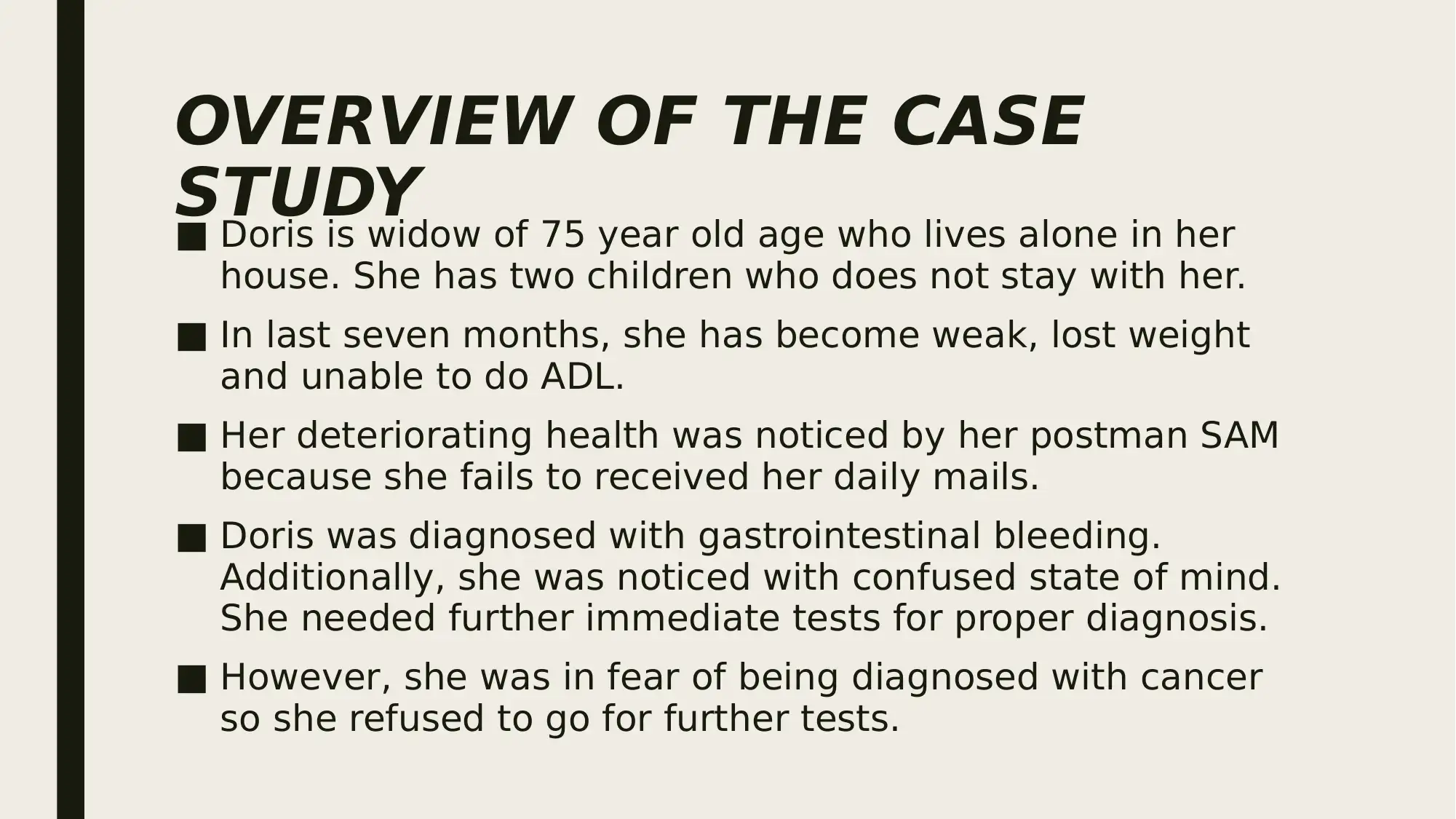
OVERVIEW OF THE CASE
STUDY■ Doris is widow of 75 year old age who lives alone in her
house. She has two children who does not stay with her.
■ In last seven months, she has become weak, lost weight
and unable to do ADL.
■ Her deteriorating health was noticed by her postman SAM
because she fails to received her daily mails.
■ Doris was diagnosed with gastrointestinal bleeding.
Additionally, she was noticed with confused state of mind.
She needed further immediate tests for proper diagnosis.
■ However, she was in fear of being diagnosed with cancer
so she refused to go for further tests.
STUDY■ Doris is widow of 75 year old age who lives alone in her
house. She has two children who does not stay with her.
■ In last seven months, she has become weak, lost weight
and unable to do ADL.
■ Her deteriorating health was noticed by her postman SAM
because she fails to received her daily mails.
■ Doris was diagnosed with gastrointestinal bleeding.
Additionally, she was noticed with confused state of mind.
She needed further immediate tests for proper diagnosis.
■ However, she was in fear of being diagnosed with cancer
so she refused to go for further tests.
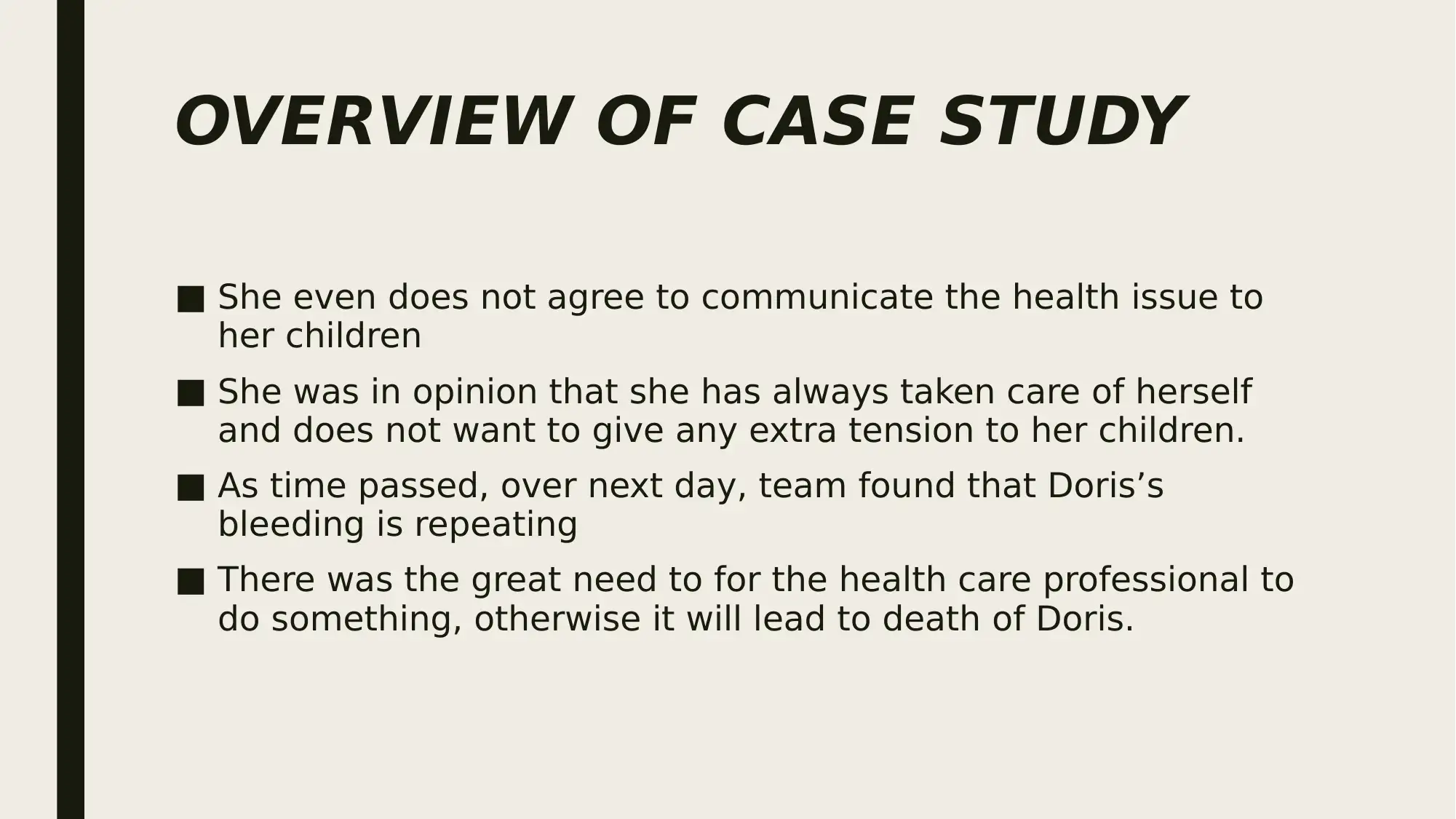
OVERVIEW OF CASE STUDY
■ She even does not agree to communicate the health issue to
her children
■ She was in opinion that she has always taken care of herself
and does not want to give any extra tension to her children.
■ As time passed, over next day, team found that Doris’s
bleeding is repeating
■ There was the great need to for the health care professional to
do something, otherwise it will lead to death of Doris.
■ She even does not agree to communicate the health issue to
her children
■ She was in opinion that she has always taken care of herself
and does not want to give any extra tension to her children.
■ As time passed, over next day, team found that Doris’s
bleeding is repeating
■ There was the great need to for the health care professional to
do something, otherwise it will lead to death of Doris.
Secure Best Marks with AI Grader
Need help grading? Try our AI Grader for instant feedback on your assignments.
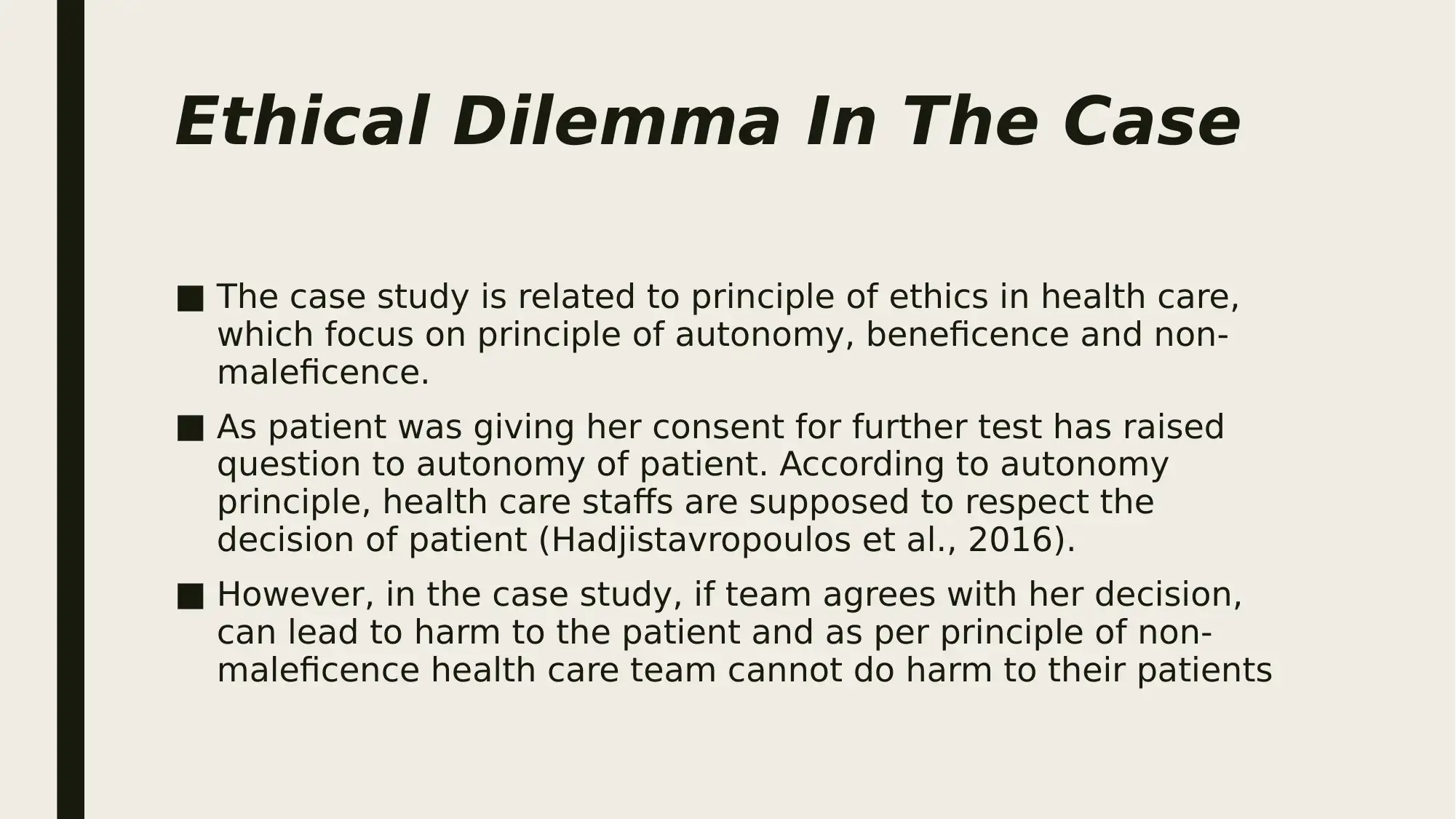
Ethical Dilemma In The Case
■ The case study is related to principle of ethics in health care,
which focus on principle of autonomy, beneficence and non-
maleficence.
■ As patient was giving her consent for further test has raised
question to autonomy of patient. According to autonomy
principle, health care staffs are supposed to respect the
decision of patient (Hadjistavropoulos et al., 2016).
■ However, in the case study, if team agrees with her decision,
can lead to harm to the patient and as per principle of non-
maleficence health care team cannot do harm to their patients
■ The case study is related to principle of ethics in health care,
which focus on principle of autonomy, beneficence and non-
maleficence.
■ As patient was giving her consent for further test has raised
question to autonomy of patient. According to autonomy
principle, health care staffs are supposed to respect the
decision of patient (Hadjistavropoulos et al., 2016).
■ However, in the case study, if team agrees with her decision,
can lead to harm to the patient and as per principle of non-
maleficence health care team cannot do harm to their patients
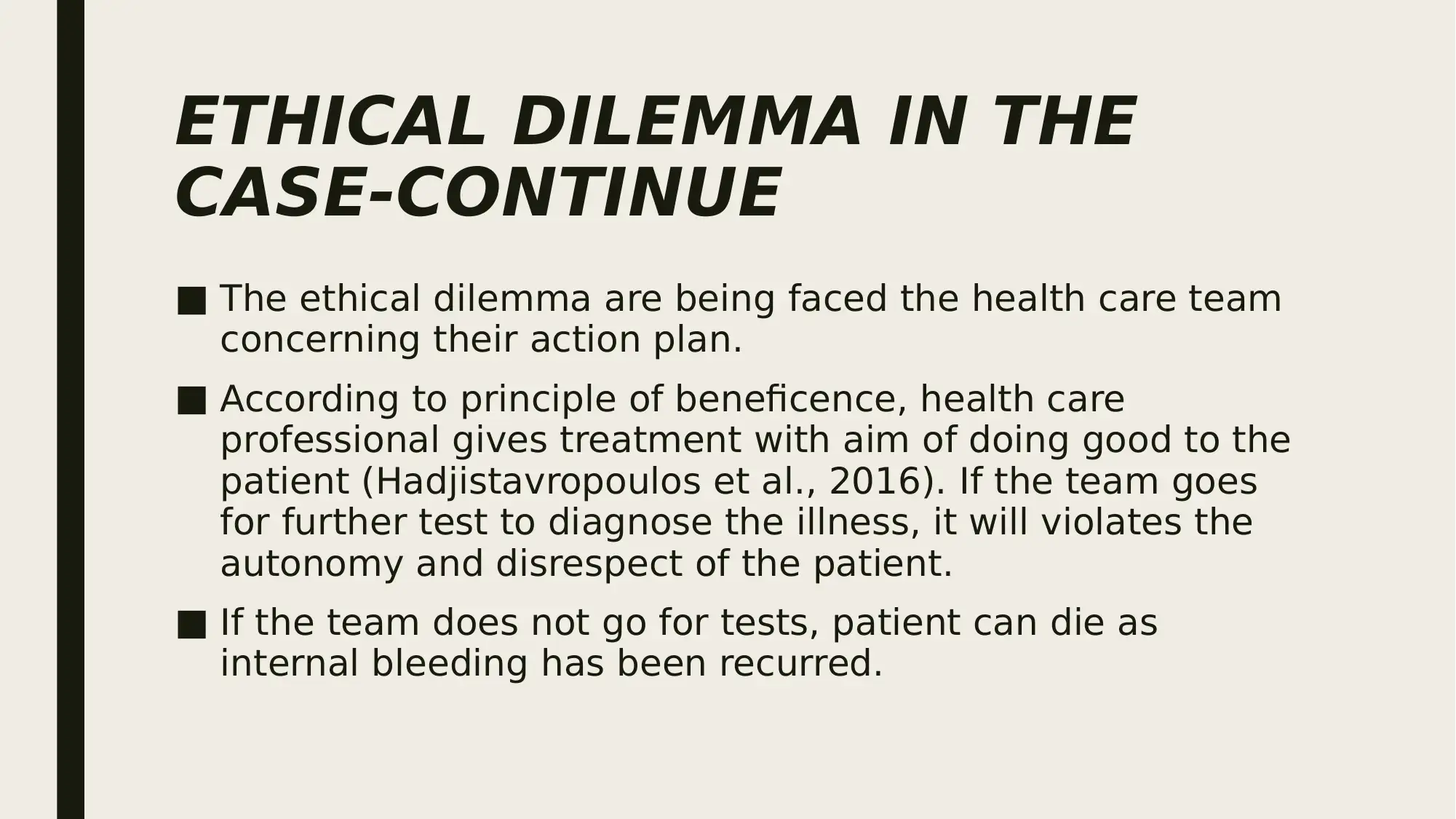
ETHICAL DILEMMA IN THE
CASE-CONTINUE
■ The ethical dilemma are being faced the health care team
concerning their action plan.
■ According to principle of beneficence, health care
professional gives treatment with aim of doing good to the
patient (Hadjistavropoulos et al., 2016). If the team goes
for further test to diagnose the illness, it will violates the
autonomy and disrespect of the patient.
■ If the team does not go for tests, patient can die as
internal bleeding has been recurred.
CASE-CONTINUE
■ The ethical dilemma are being faced the health care team
concerning their action plan.
■ According to principle of beneficence, health care
professional gives treatment with aim of doing good to the
patient (Hadjistavropoulos et al., 2016). If the team goes
for further test to diagnose the illness, it will violates the
autonomy and disrespect of the patient.
■ If the team does not go for tests, patient can die as
internal bleeding has been recurred.
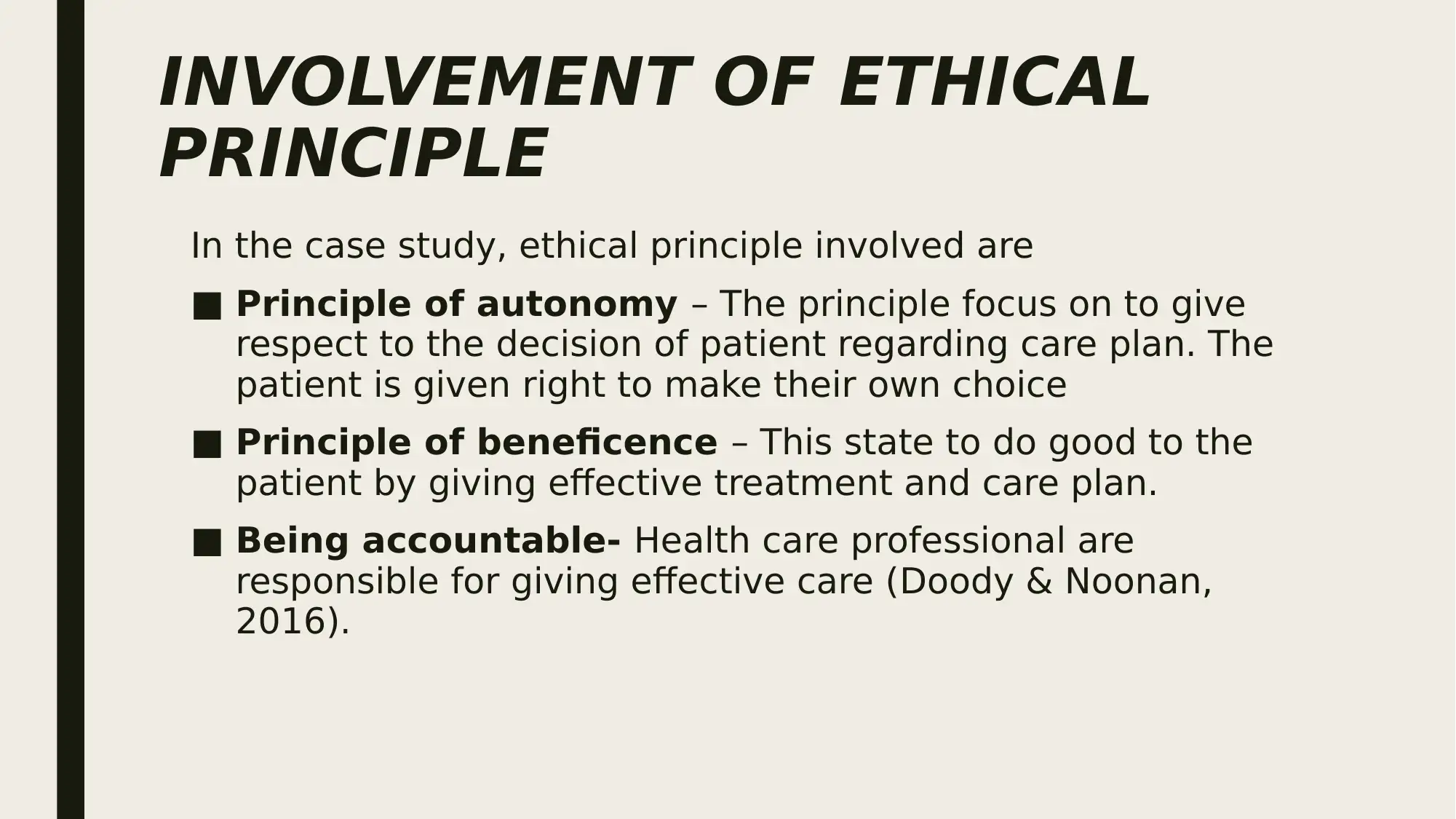
INVOLVEMENT OF ETHICAL
PRINCIPLE
In the case study, ethical principle involved are
■ Principle of autonomy – The principle focus on to give
respect to the decision of patient regarding care plan. The
patient is given right to make their own choice
■ Principle of beneficence – This state to do good to the
patient by giving effective treatment and care plan.
■ Being accountable- Health care professional are
responsible for giving effective care (Doody & Noonan,
2016).
PRINCIPLE
In the case study, ethical principle involved are
■ Principle of autonomy – The principle focus on to give
respect to the decision of patient regarding care plan. The
patient is given right to make their own choice
■ Principle of beneficence – This state to do good to the
patient by giving effective treatment and care plan.
■ Being accountable- Health care professional are
responsible for giving effective care (Doody & Noonan,
2016).
Paraphrase This Document
Need a fresh take? Get an instant paraphrase of this document with our AI Paraphraser
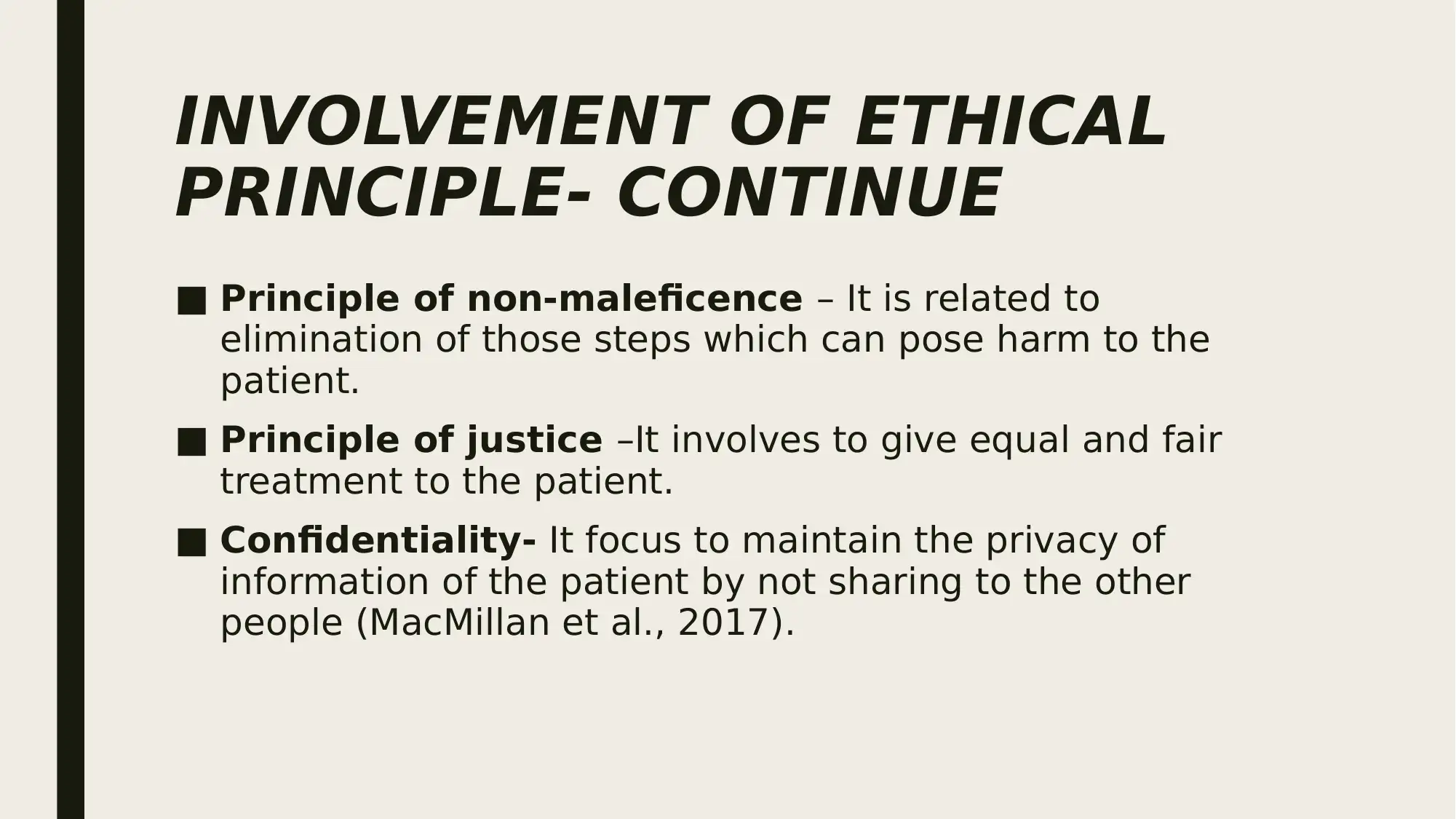
INVOLVEMENT OF ETHICAL
PRINCIPLE- CONTINUE
■ Principle of non-maleficence – It is related to
elimination of those steps which can pose harm to the
patient.
■ Principle of justice –It involves to give equal and fair
treatment to the patient.
■ Confidentiality- It focus to maintain the privacy of
information of the patient by not sharing to the other
people (MacMillan et al., 2017).
PRINCIPLE- CONTINUE
■ Principle of non-maleficence – It is related to
elimination of those steps which can pose harm to the
patient.
■ Principle of justice –It involves to give equal and fair
treatment to the patient.
■ Confidentiality- It focus to maintain the privacy of
information of the patient by not sharing to the other
people (MacMillan et al., 2017).
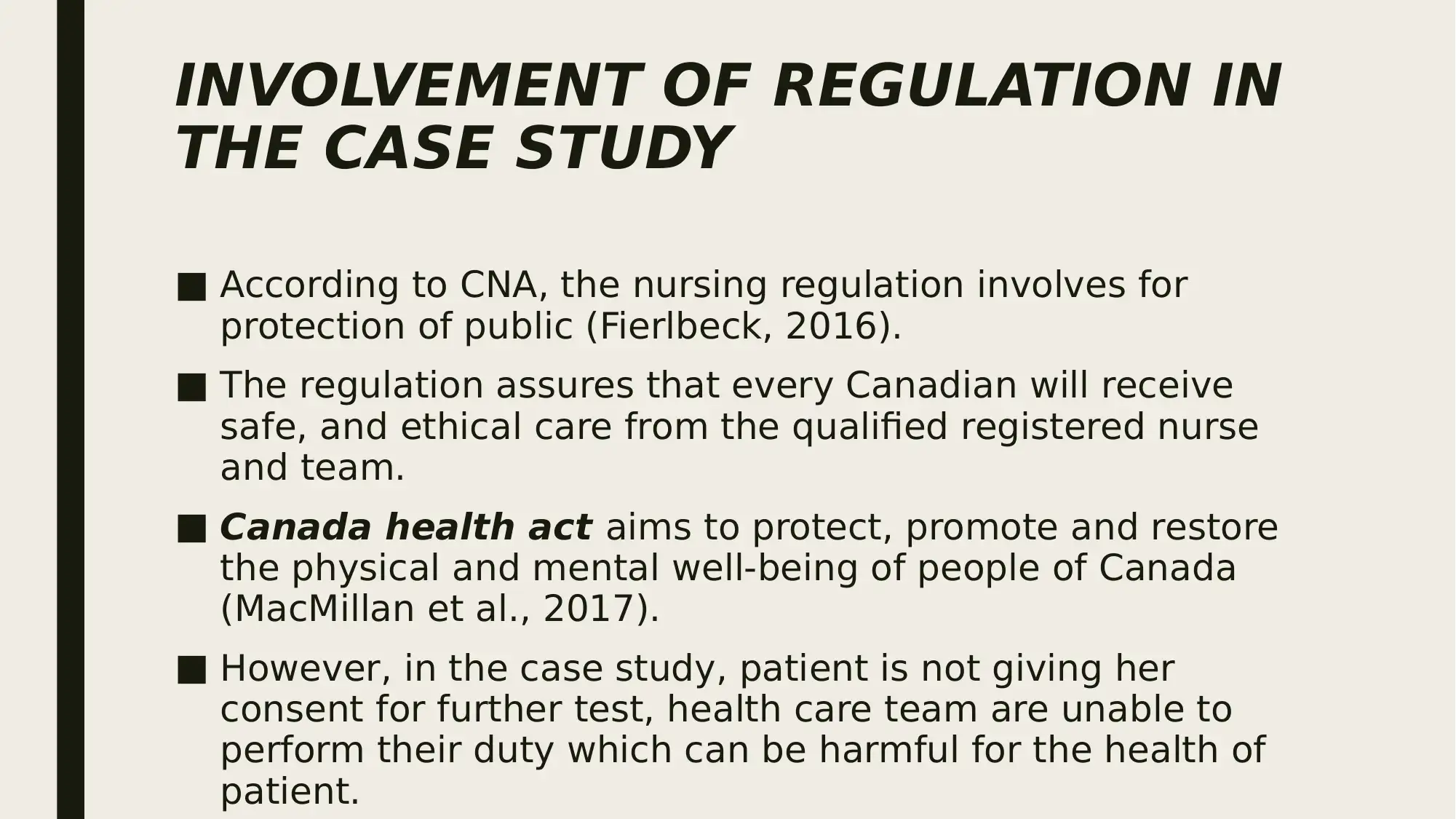
INVOLVEMENT OF REGULATION IN
THE CASE STUDY
■ According to CNA, the nursing regulation involves for
protection of public (Fierlbeck, 2016).
■ The regulation assures that every Canadian will receive
safe, and ethical care from the qualified registered nurse
and team.
■ Canada health act aims to protect, promote and restore
the physical and mental well-being of people of Canada
(MacMillan et al., 2017).
■ However, in the case study, patient is not giving her
consent for further test, health care team are unable to
perform their duty which can be harmful for the health of
patient.
THE CASE STUDY
■ According to CNA, the nursing regulation involves for
protection of public (Fierlbeck, 2016).
■ The regulation assures that every Canadian will receive
safe, and ethical care from the qualified registered nurse
and team.
■ Canada health act aims to protect, promote and restore
the physical and mental well-being of people of Canada
(MacMillan et al., 2017).
■ However, in the case study, patient is not giving her
consent for further test, health care team are unable to
perform their duty which can be harmful for the health of
patient.
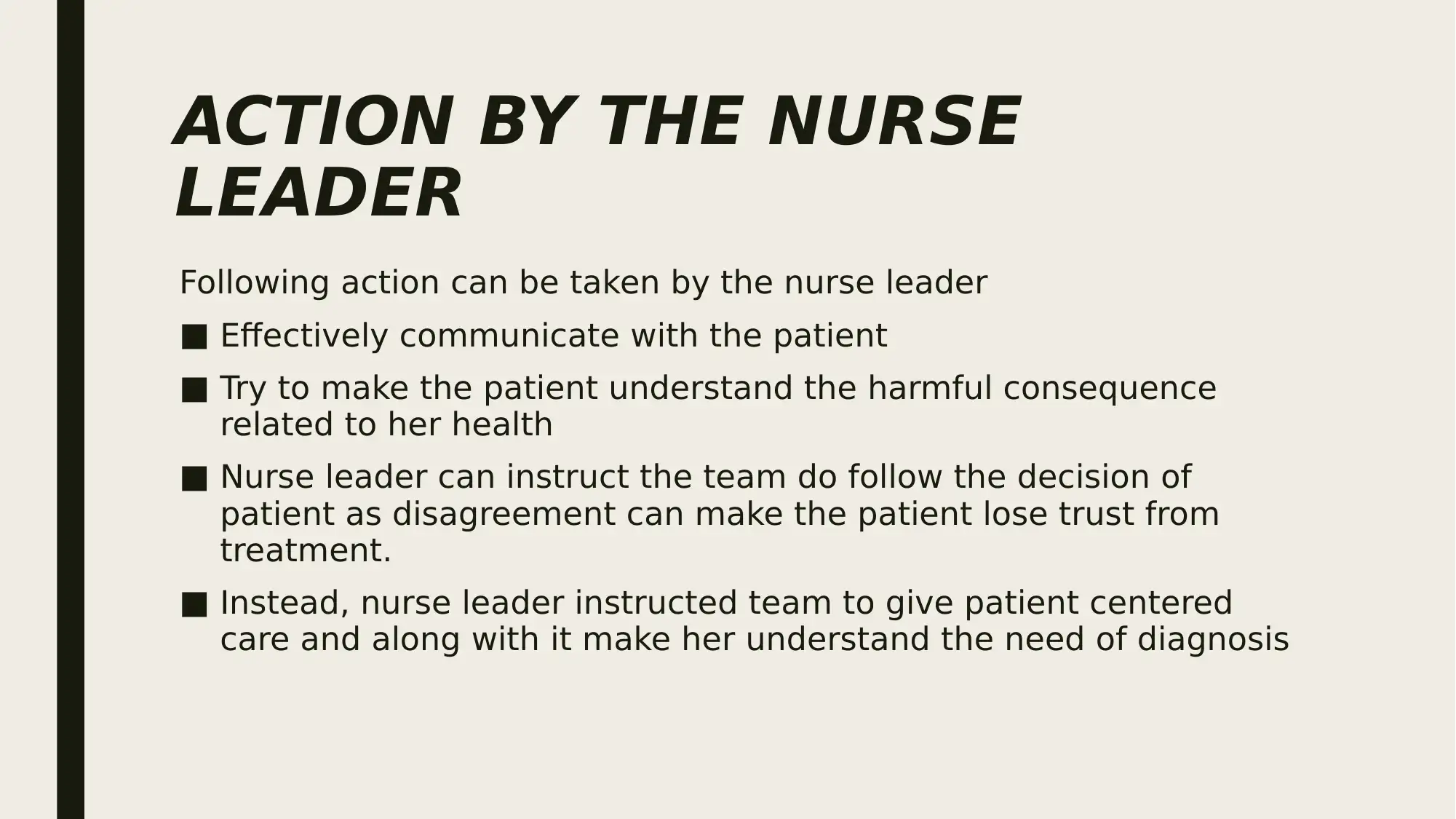
ACTION BY THE NURSE
LEADER
Following action can be taken by the nurse leader
■ Effectively communicate with the patient
■ Try to make the patient understand the harmful consequence
related to her health
■ Nurse leader can instruct the team do follow the decision of
patient as disagreement can make the patient lose trust from
treatment.
■ Instead, nurse leader instructed team to give patient centered
care and along with it make her understand the need of diagnosis
LEADER
Following action can be taken by the nurse leader
■ Effectively communicate with the patient
■ Try to make the patient understand the harmful consequence
related to her health
■ Nurse leader can instruct the team do follow the decision of
patient as disagreement can make the patient lose trust from
treatment.
■ Instead, nurse leader instructed team to give patient centered
care and along with it make her understand the need of diagnosis
Secure Best Marks with AI Grader
Need help grading? Try our AI Grader for instant feedback on your assignments.
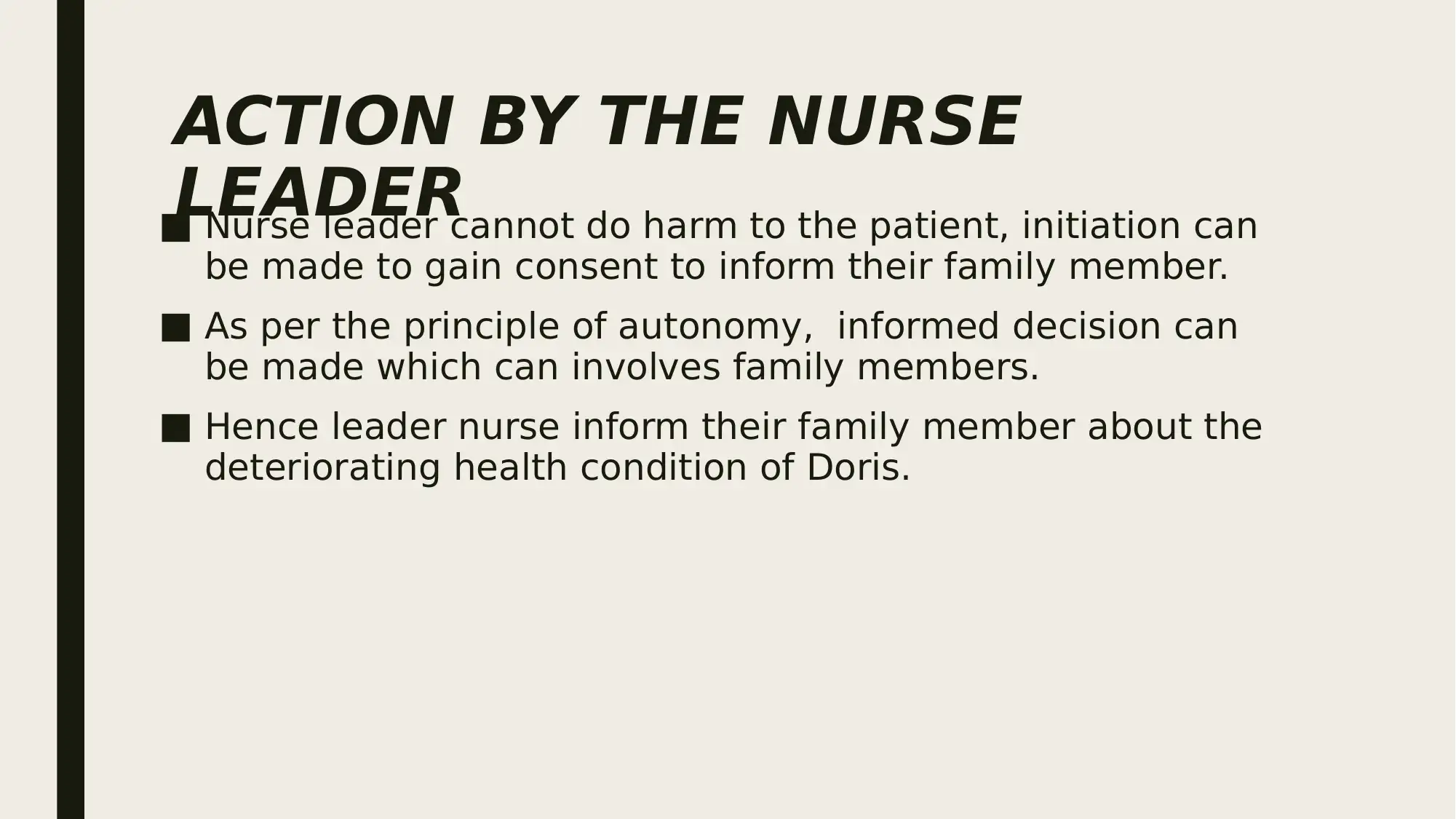
ACTION BY THE NURSE
LEADER■ Nurse leader cannot do harm to the patient, initiation can
be made to gain consent to inform their family member.
■ As per the principle of autonomy, informed decision can
be made which can involves family members.
■ Hence leader nurse inform their family member about the
deteriorating health condition of Doris.
LEADER■ Nurse leader cannot do harm to the patient, initiation can
be made to gain consent to inform their family member.
■ As per the principle of autonomy, informed decision can
be made which can involves family members.
■ Hence leader nurse inform their family member about the
deteriorating health condition of Doris.
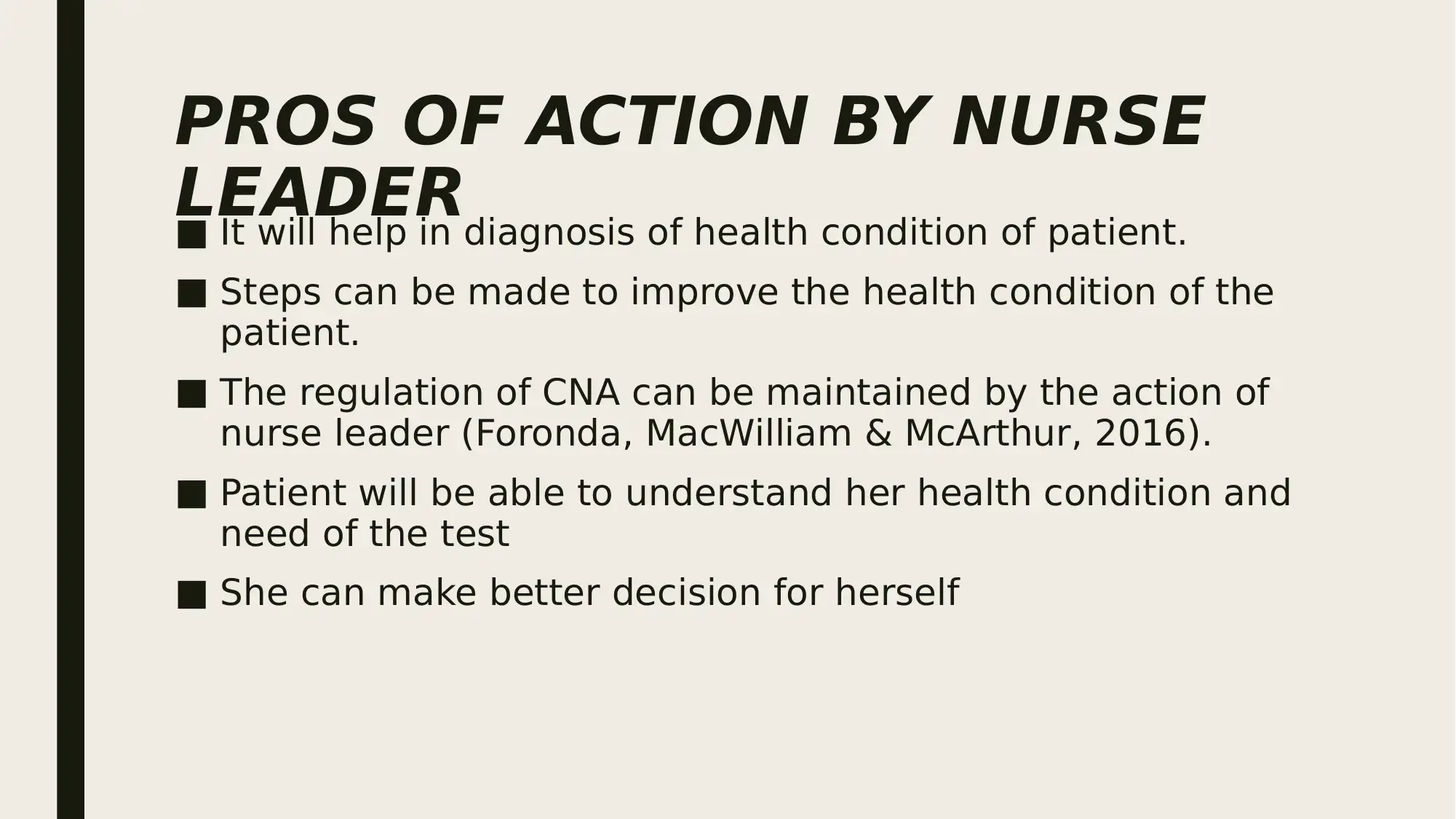
PROS OF ACTION BY NURSE
LEADER■ It will help in diagnosis of health condition of patient.
■ Steps can be made to improve the health condition of the
patient.
■ The regulation of CNA can be maintained by the action of
nurse leader (Foronda, MacWilliam & McArthur, 2016).
■ Patient will be able to understand her health condition and
need of the test
■ She can make better decision for herself
LEADER■ It will help in diagnosis of health condition of patient.
■ Steps can be made to improve the health condition of the
patient.
■ The regulation of CNA can be maintained by the action of
nurse leader (Foronda, MacWilliam & McArthur, 2016).
■ Patient will be able to understand her health condition and
need of the test
■ She can make better decision for herself
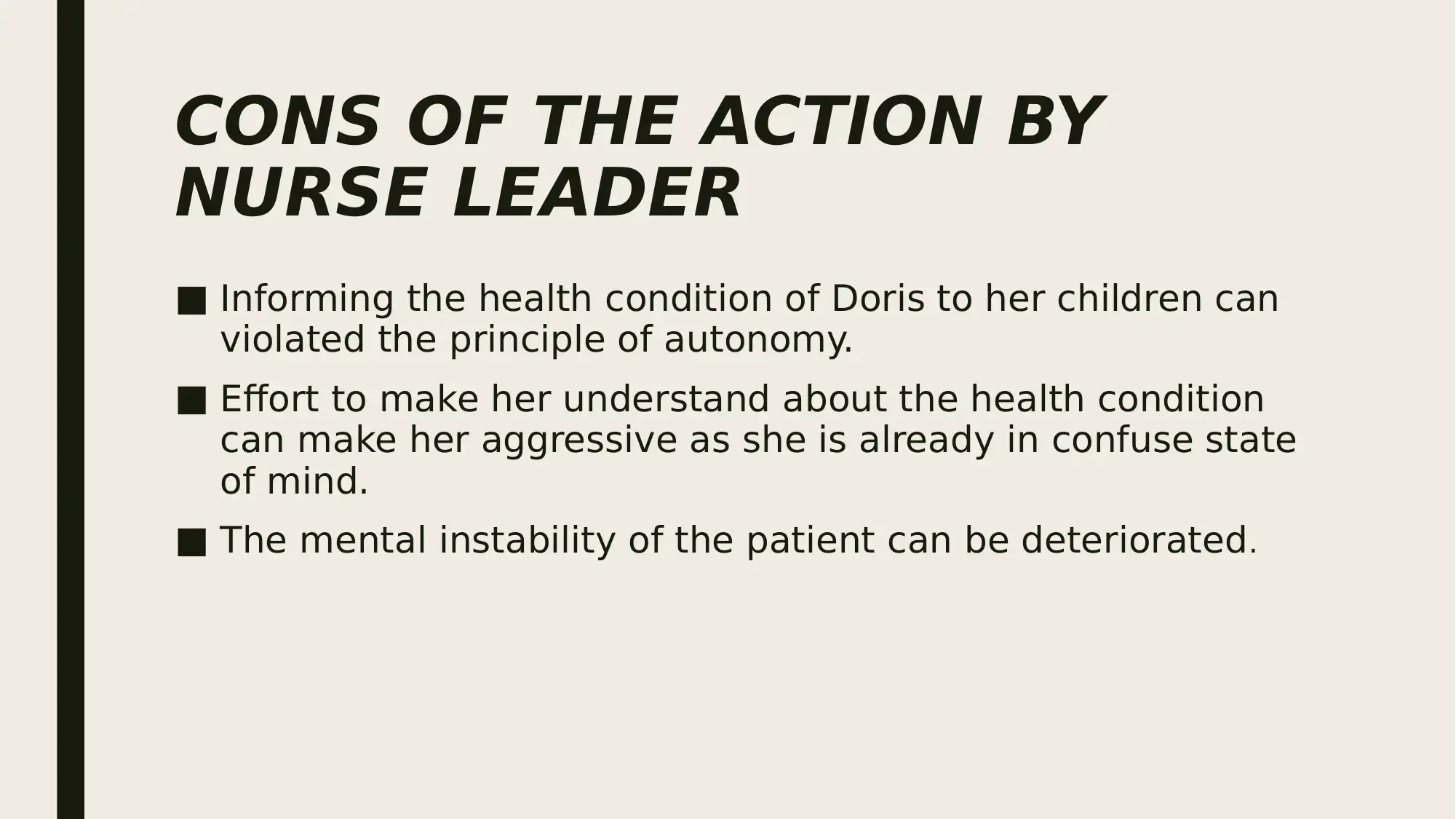
CONS OF THE ACTION BY
NURSE LEADER
■ Informing the health condition of Doris to her children can
violated the principle of autonomy.
■ Effort to make her understand about the health condition
can make her aggressive as she is already in confuse state
of mind.
■ The mental instability of the patient can be deteriorated.
NURSE LEADER
■ Informing the health condition of Doris to her children can
violated the principle of autonomy.
■ Effort to make her understand about the health condition
can make her aggressive as she is already in confuse state
of mind.
■ The mental instability of the patient can be deteriorated.
Paraphrase This Document
Need a fresh take? Get an instant paraphrase of this document with our AI Paraphraser
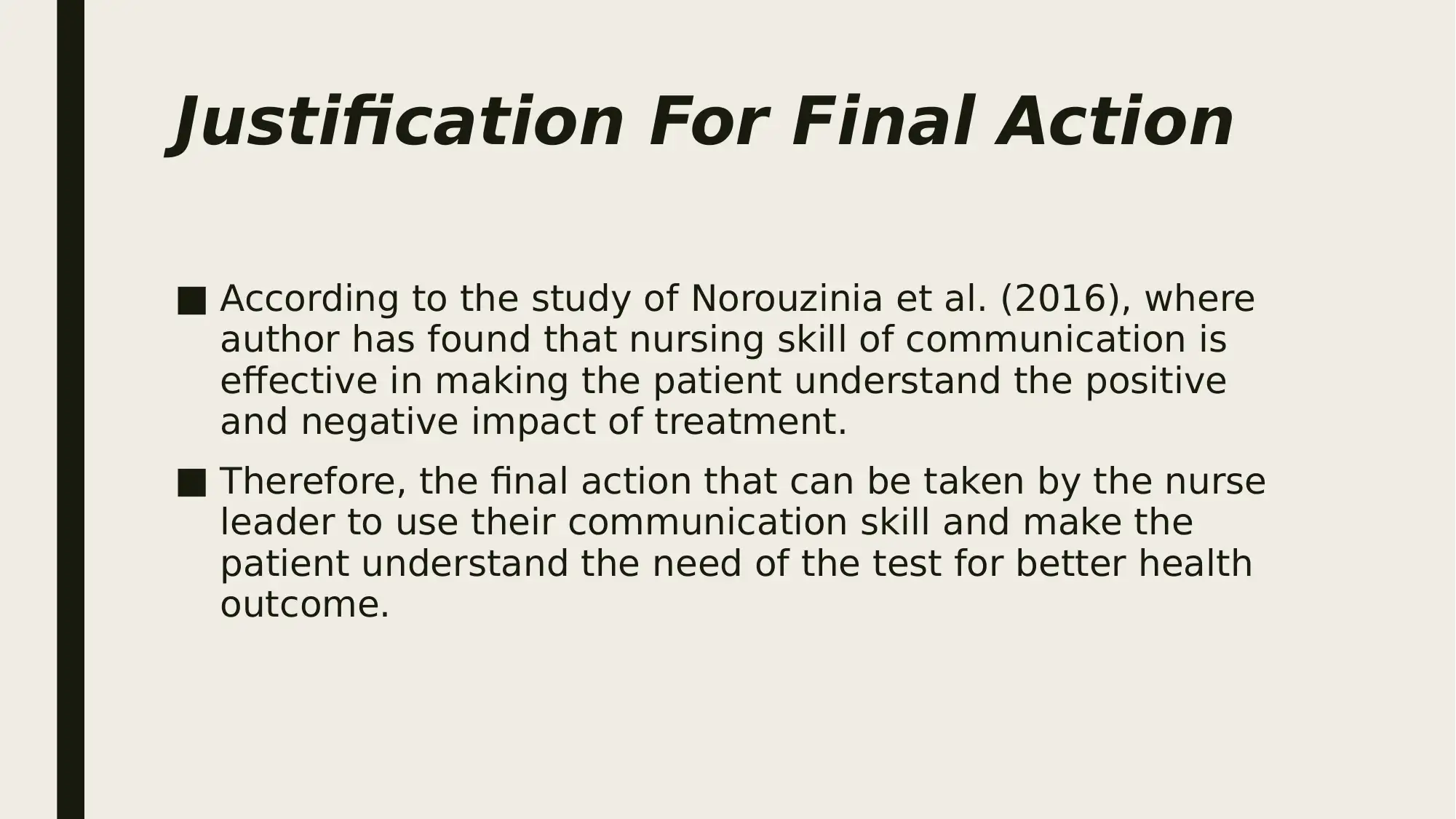
Justification For Final Action
■ According to the study of Norouzinia et al. (2016), where
author has found that nursing skill of communication is
effective in making the patient understand the positive
and negative impact of treatment.
■ Therefore, the final action that can be taken by the nurse
leader to use their communication skill and make the
patient understand the need of the test for better health
outcome.
■ According to the study of Norouzinia et al. (2016), where
author has found that nursing skill of communication is
effective in making the patient understand the positive
and negative impact of treatment.
■ Therefore, the final action that can be taken by the nurse
leader to use their communication skill and make the
patient understand the need of the test for better health
outcome.
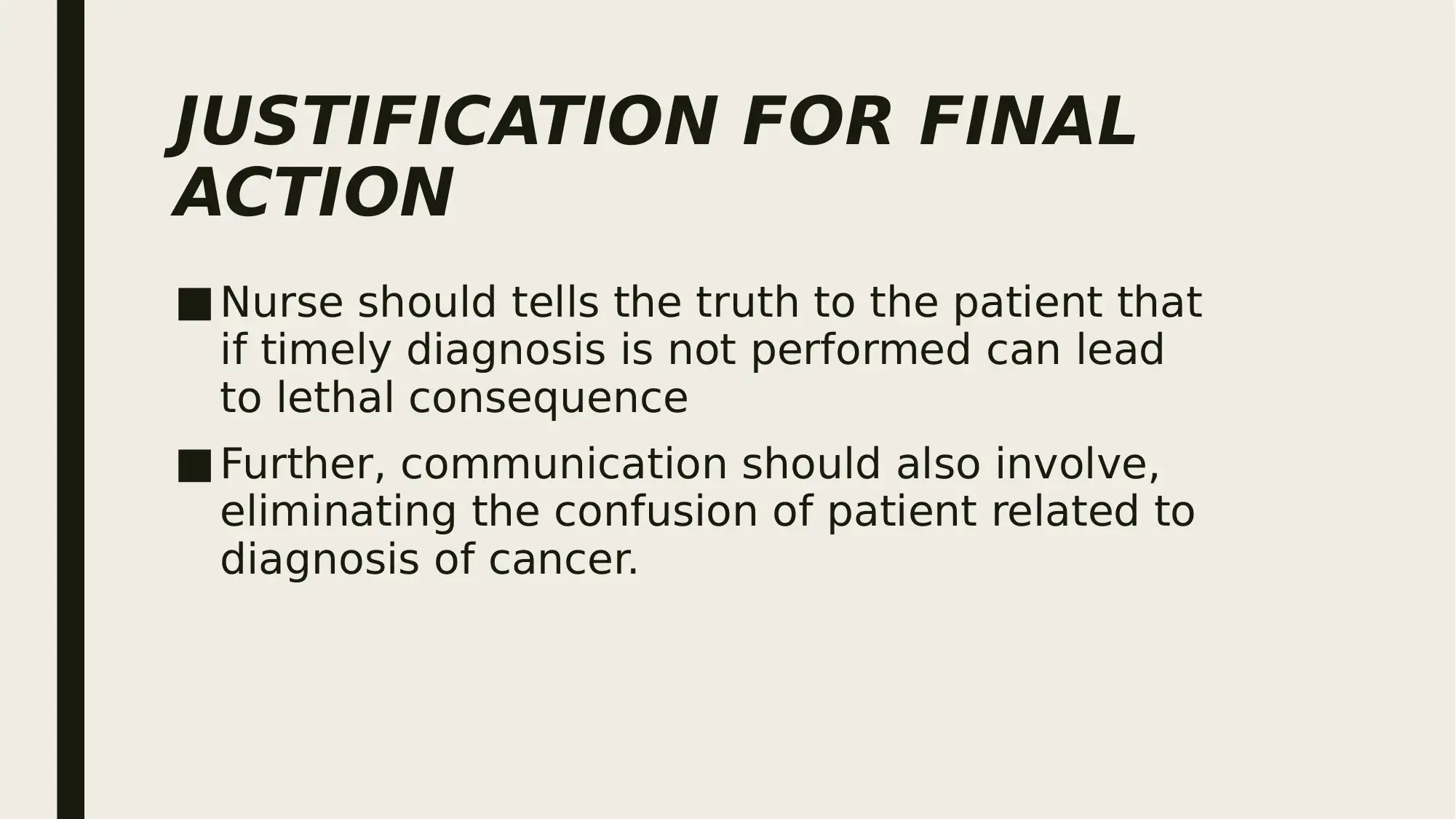
JUSTIFICATION FOR FINAL
ACTION
■ Nurse should tells the truth to the patient that
if timely diagnosis is not performed can lead
to lethal consequence
■ Further, communication should also involve,
eliminating the confusion of patient related to
diagnosis of cancer.
ACTION
■ Nurse should tells the truth to the patient that
if timely diagnosis is not performed can lead
to lethal consequence
■ Further, communication should also involve,
eliminating the confusion of patient related to
diagnosis of cancer.
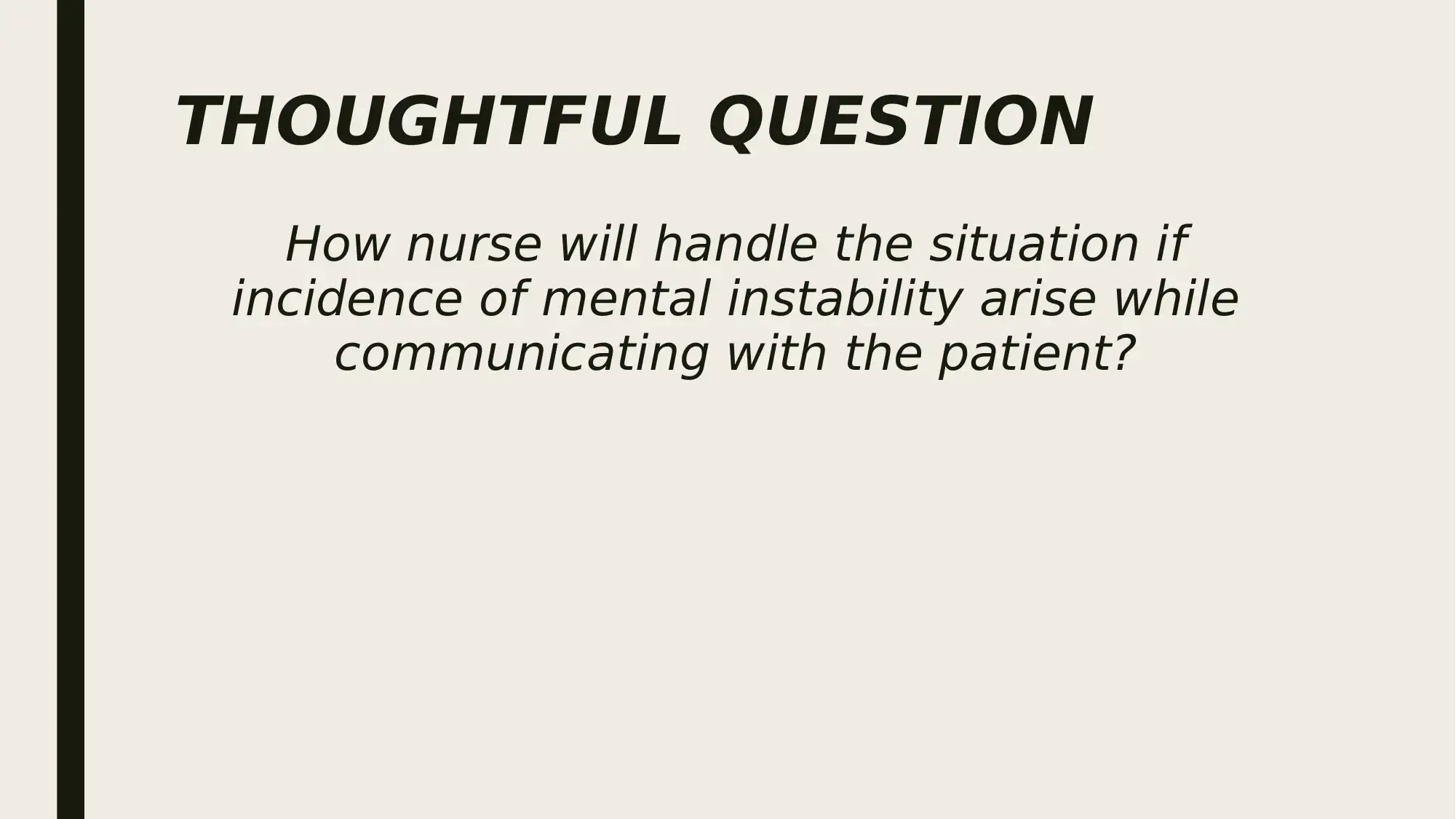
THOUGHTFUL QUESTION
How nurse will handle the situation if
incidence of mental instability arise while
communicating with the patient?
How nurse will handle the situation if
incidence of mental instability arise while
communicating with the patient?
Secure Best Marks with AI Grader
Need help grading? Try our AI Grader for instant feedback on your assignments.
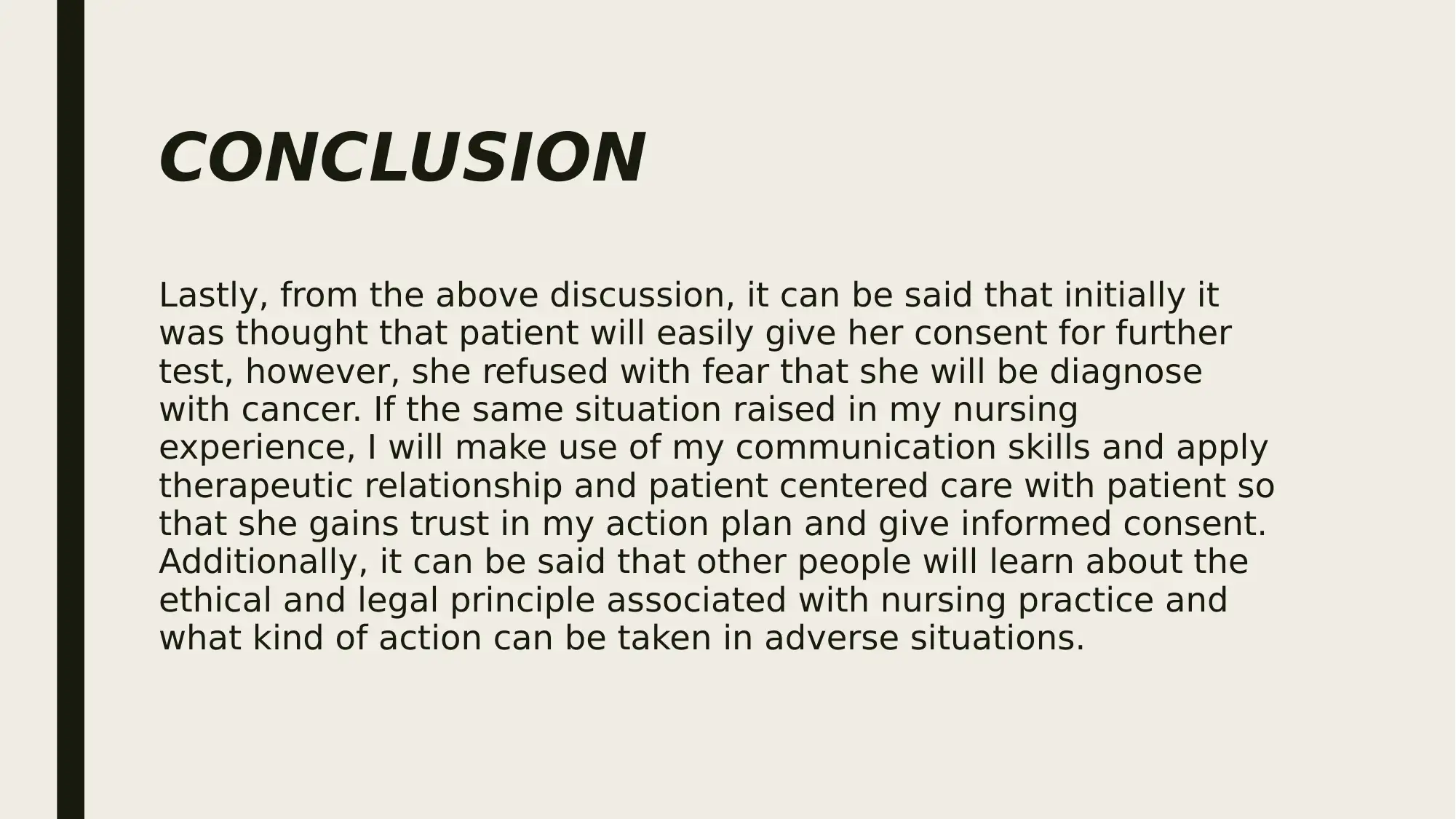
CONCLUSION
Lastly, from the above discussion, it can be said that initially it
was thought that patient will easily give her consent for further
test, however, she refused with fear that she will be diagnose
with cancer. If the same situation raised in my nursing
experience, I will make use of my communication skills and apply
therapeutic relationship and patient centered care with patient so
that she gains trust in my action plan and give informed consent.
Additionally, it can be said that other people will learn about the
ethical and legal principle associated with nursing practice and
what kind of action can be taken in adverse situations.
Lastly, from the above discussion, it can be said that initially it
was thought that patient will easily give her consent for further
test, however, she refused with fear that she will be diagnose
with cancer. If the same situation raised in my nursing
experience, I will make use of my communication skills and apply
therapeutic relationship and patient centered care with patient so
that she gains trust in my action plan and give informed consent.
Additionally, it can be said that other people will learn about the
ethical and legal principle associated with nursing practice and
what kind of action can be taken in adverse situations.
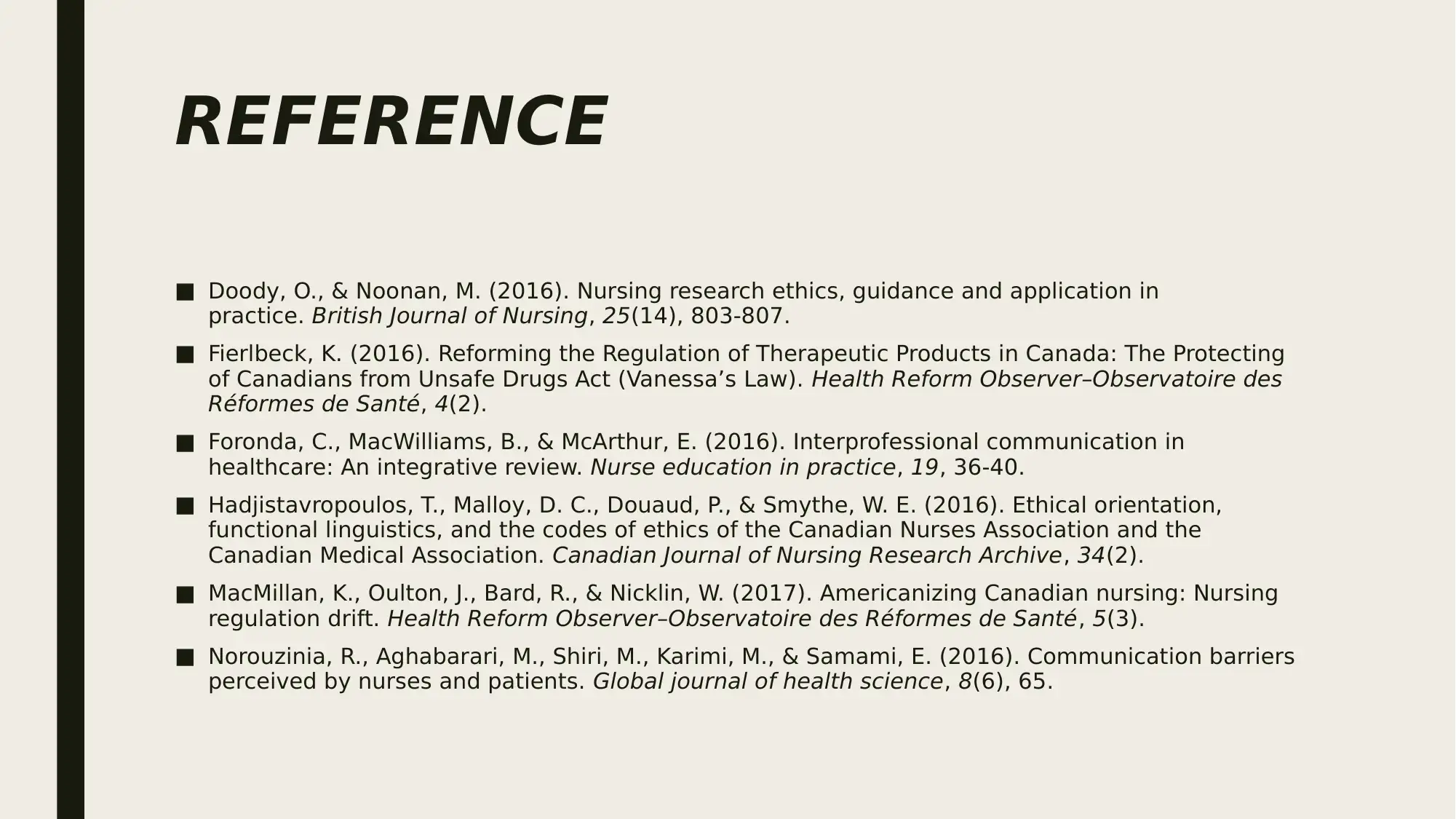
REFERENCE
■ Doody, O., & Noonan, M. (2016). Nursing research ethics, guidance and application in
practice. British Journal of Nursing, 25(14), 803-807.
■ Fierlbeck, K. (2016). Reforming the Regulation of Therapeutic Products in Canada: The Protecting
of Canadians from Unsafe Drugs Act (Vanessa’s Law). Health Reform Observer–Observatoire des
Réformes de Santé, 4(2).
■ Foronda, C., MacWilliams, B., & McArthur, E. (2016). Interprofessional communication in
healthcare: An integrative review. Nurse education in practice, 19, 36-40.
■ Hadjistavropoulos, T., Malloy, D. C., Douaud, P., & Smythe, W. E. (2016). Ethical orientation,
functional linguistics, and the codes of ethics of the Canadian Nurses Association and the
Canadian Medical Association. Canadian Journal of Nursing Research Archive, 34(2).
■ MacMillan, K., Oulton, J., Bard, R., & Nicklin, W. (2017). Americanizing Canadian nursing: Nursing
regulation drift. Health Reform Observer–Observatoire des Réformes de Santé, 5(3).
■ Norouzinia, R., Aghabarari, M., Shiri, M., Karimi, M., & Samami, E. (2016). Communication barriers
perceived by nurses and patients. Global journal of health science, 8(6), 65.
■ Doody, O., & Noonan, M. (2016). Nursing research ethics, guidance and application in
practice. British Journal of Nursing, 25(14), 803-807.
■ Fierlbeck, K. (2016). Reforming the Regulation of Therapeutic Products in Canada: The Protecting
of Canadians from Unsafe Drugs Act (Vanessa’s Law). Health Reform Observer–Observatoire des
Réformes de Santé, 4(2).
■ Foronda, C., MacWilliams, B., & McArthur, E. (2016). Interprofessional communication in
healthcare: An integrative review. Nurse education in practice, 19, 36-40.
■ Hadjistavropoulos, T., Malloy, D. C., Douaud, P., & Smythe, W. E. (2016). Ethical orientation,
functional linguistics, and the codes of ethics of the Canadian Nurses Association and the
Canadian Medical Association. Canadian Journal of Nursing Research Archive, 34(2).
■ MacMillan, K., Oulton, J., Bard, R., & Nicklin, W. (2017). Americanizing Canadian nursing: Nursing
regulation drift. Health Reform Observer–Observatoire des Réformes de Santé, 5(3).
■ Norouzinia, R., Aghabarari, M., Shiri, M., Karimi, M., & Samami, E. (2016). Communication barriers
perceived by nurses and patients. Global journal of health science, 8(6), 65.
1 out of 18
Related Documents
Your All-in-One AI-Powered Toolkit for Academic Success.
+13062052269
info@desklib.com
Available 24*7 on WhatsApp / Email
![[object Object]](/_next/static/media/star-bottom.7253800d.svg)
Unlock your academic potential
© 2024 | Zucol Services PVT LTD | All rights reserved.



